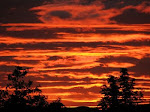
A group of the men who worked at a classified military radio relay station on Table Mountain during World War II.
The Original Radarsite
 A note from Radarsite: Some time ago I posted an article honoring the generosity and kindness of the good people of Stephenville, Newfoudland, who extended a welcoming hand to those airline passengers who on 9/11 had been rerouted to Newfoundland
A note from Radarsite: Some time ago I posted an article honoring the generosity and kindness of the good people of Stephenville, Newfoudland, who extended a welcoming hand to those airline passengers who on 9/11 had been rerouted to Newfoundlandhttp://radarsite.blogspot.com/2008/05/pain-and-passage-belated-tribute.html.
Today I received this surprise in my email from Christopher Vaughan, the editor on the local Stephenville newspaper, The Georgian. This is a picture of the original Radarsite pictured in the header on which I was stationed in 1959-61. I hope you find this as fascinating as I do.
It is surprises like this one which make the internet so exciting and unpredictable. - rg
------------------------------------------------------------------------
High service
Veteran recalls wartime atop Table Mountain
NATALIE MUSSEAU
The Gulf News
07/07/08
The ruins of a classified military radio relay station on Table Mountain are fading into the scenery a little more with each passing year.
But Gordon Misner's memories of his 14 months stationed there during World War II are still clear.
From its 1,700-foot top, radio signals were clear and U-Boats could be seen in the Gulf of St. Lawrence.
Ten men of the Royal Canadian Air Force lived on Table Mountain in near isolation during the war, including Ontario native Mr. Misner, who was stationed there from November 1943 until December 1944.
Mr. Misner joined the air force in early 1942 - he was about 19 at the time. He attended wireless school in Hamilton, was transferred to Montreal for further technical training and worked with a fighter squadron in Gander before being posted to Cape Ray.
The job at Table Mountain involved operating and maintaining the radio equipment and other necessary work.
Much of the equipment was hauled to the site with the help of two dog teams. The men constructed much of the buildings themselves, sleeping in a shed at the base of the mountain until the barracks at the top, held down by heavy rocks, were completed.
It wasn't a desk job, said Mr. Misner, adding everyone pitched in to do whatever was needed. Sometimes the tractor would be stuck in the snow or the frozen plumbing would need to be thawed.
"We melted snow then to use for our laundry as well in early times," said Mr. Misner.
He rigged up an outdoor shower before construction workers finally fixed the indoor facilities, installing central water heating.
The construction foreman left behind his dog, Skipper, to keep the men company on the long, cold nights. Mr. Misner recalls that the dog became everyone's pet and a mascot of sorts for the outpost - which was classed as 'overseas' at the time.
He remembered Skipper laying at his feet when he would work the night shift, listening to music and some of the programs on the radio that were popular.
Sometimes the men used Skipper to help guide them home, tying a rope around their waist and Skipper's neck so he could lead them through the fog or snow.
The dog also ate his share of the men's dinner at Christmas. The Sally Ann in Port aux Basques delivered the turkey and trimmings by tractor and truck up the mountain.
Some supplies were delivered to the site through airdrops and the men often had to run after the falling parachutes before the wind carried them and the needed supplies over the edge of the mountain.
If the weather was bad, no drop was made, which was disappointing to the men who, although quite used to dehydrated and canned supplies, looked forward to fresh food.
Mr. Misner often helped out the cook, named Thibeault, by baking bread or making pancakes on Sunday mornings when Thibeault slept late. He also was the barber for the men, making sure their hair stayed military style.
"I guess who could, did it," he said. "It was a cooperative group."
The men often went down the mountain in pairs to collect the mail. It was a seven mile trek with each man carrying a heavy load down and returning up the slope with up to 50 pounds on a backboard.
One tall, thin American man nicknamed Slim perished on the journey. He and another man encountered heavy snow on their way back and walked in circles. The survivor went for help, and he, Mr. Misner and three other servicemen helped bring Slim back to the barracks.
"It was really pioneer existence," he said.
All the jobs were done amidst unpredictable weather. Mr. Misner recalled the summer as a time of fog and black flies, without any truly hot weather. Sometimes, he said, the sun would be shining on top of the mountain while cloud hung over the people below.
"In the winter, the wind would howl, but there seemed to be high winds most of the time," he said. "There was lots of snow which came down horizontally instead of the regular way."
Mr. Misner said the lady in charge of the railway stop in Cape Ray would say, 'you boys are going to perish up there.' Others in the community they had contact with also expressed disbelief at the location.
But even through some of the hardships, some of the men, including himself, took advantage of the snowy slope to do some skiing, Mr. Misner remembered. Government issued each man a pair of skis and snowshoes.
He said he enjoyed the work and being with a small group of fellow service men.
Read the rest here:
http://www.gulfnews.ca/index.cfm?sid=150329&sc=342&comments
 A special thanks to Wayne of "Table Mountain" for sending Radarsite this great photo of Table Mountain [click on it to enlarge] http://tablemountains.blogspot.com/
A special thanks to Wayne of "Table Mountain" for sending Radarsite this great photo of Table Mountain [click on it to enlarge] http://tablemountains.blogspot.com/





























.jpg)








.jpg)



































































.jpg)

.jpg)











.jpg)



















It takes a special type of person to man these stations. They are still in effect up north, watching for trouble and guarding our lives.
ReplyDeleteThanks for sharing this, Roger. We forget the sacrifices that have been done to keep us free. Stories like this reminds us of them.
Roger
ReplyDeleteThanks for the article, this type of Special People who sacrifice for the good of the country are never now or later appreciated by the current crop of loons that seem to be living and are allowed to procreate their Anti- America rethoric in our midst!
were hoping to have a storyboard made in our community soon. it'll be where you can still look up and see the old radar on the table mountains. it'll show the deeds of men like mr. misner of the RCAF and the americans who served there also.more info and pics of the area on my blog.
ReplyDeletehttp://tablemountains.blogspot.com/
Roger, Thank you for sharing a great piece of History.
ReplyDeleteI thoroughly enjoyed reading and love the picture! God Bless all of them.
Thanks Findalis and Redhawk.
ReplyDeleteAnd what a pleasant surprise to meet you Wayne from "Table Mountain" (Webmaster). I highly recommend visting Wayne's great site for more pics of Table Mountain and much more.
In the years since that time, when I've had occasion to attempt to describe what it was like living up there for a year and a half, people probably thought I that was exaggerating. But I wasn't. During the winter months the winds grew so powerful that they had to connect the building together with ropes, so that you could get from one building to another without being blown off the mountain. When the winds hit 80 knots per hours the siren would go off and you'd have to make it inside quick -- or else. lol. The first winter I was up there, the wind blew the whole second story of a barracks off the mountaintop. It happened to be our library, and the books were scattered all over Newfoundland snf hopefully helped to raise the literacy rate. The sound of the winds howling in the valleys below was so loud and disturbing that you could hardly sleep at night, like the sounds of a thousand women wailing. I can still hear that sound today.
These memories are of course personal, but I hope that they are interesting to others as well.
rg
What a great article- and a wonderful story to be reminded of. I must confess that I hadn't learned about or understood radio relay, short wave messaging, etc.. until a few years ago when I discovered letters written to my great-grandmother alerting her that my grandfather was captured in Tunisia and being held as a POW in Germany. More than 70 short wave listeners around the country heard about his capture and imprisonment via enemy radio and wrote to her. I was so moved I wrote up the story in World War II Radio Heroes. My hat is off to each one of the men who worked on Table Mountain and the great people who supported them.
ReplyDelete